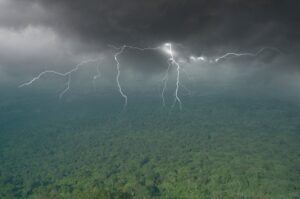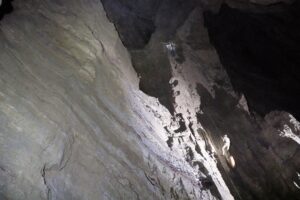It was the night the stars fell. In 1833, people across North America witnessed a powerful celestial event that appeared downright apocalyptic. Hundreds of thousands of streams of fire lit up the night sky in a massive shower that lasted from the early hours of the morning to the cusp of sunrise.
Eyewitness accounts
Reports from across the country on November 12 and November 13 described the meteor shower as “like snowflakes” or a “shower of stars.” This reflects the huge number of meteors visible from Earth that night, a whopping 150,000 meteors per hour.
An article from the Arkansas Gazette by William Woodruff described it as a “remarkable phenomena…they could be seen in every quarter and flying in every direction, though generally toward the southwest, and kept up an incessant illumination of the heavens.”
Woodruff went on to note that the event began late night/early morning and the sky was clear. The meteor shower was only visible in North America.

Perseid meteors. Photo: Prokhor Minin/Unsplash
Researching the phenomenon, American astronomer Denison Olmsted sent out a public appeal for witness testimonies. He asked for “the time when it was first discovered, the position of the radiant point above mentioned, whether progressive or stationary, and any other facts relative to the meteors.” People answered his call and Olmsted eventually published his findings in the American Journal of Science and Arts the next year. Some credit this venture as the first use of crowdsourcing for scientific research.
Other accounts of the 1833 shower include those of various Native American tribes, Abraham Lincoln, Joseph Smith, and Frederick Douglas.
The cause
At the time, there had been limited research into meteor showers. Astronomers had not yet found a link between the showers and comet debris, nor the influences of gravity, the Sun, and other planets. Therefore, many interpreted the event as something supernatural, ranging from a harbinger of Christ’s second coming to God’s wrath. Some observers feared that meteors would hit Earth, but they skimmed past Earth.
The true cause of the spectacular meteor shower was the constellation of Leo. Officially known as the Leonids, this meteor shower puts on a spectacular show for stargazers every 33 years, around November. So, unbeknownst to onlookers in 1833, the intense meteor shower was not a one-off event. According to historical records, it dates back to at least 900 A.D.

Leonids in 2000. Photo: NASA
Leonids meteors shot across the sky at 72km per second, with some leaving smoky trails in their wake.
Though these meteors are very bright and appear quite large, they are in fact as small as 10mm. They originate from the Tempel-Tuttle comet which has an orbital period of 33 years. Subsequent research into the 1833 shower found a definitive link between the body and the event. The fragments are pieces of rock and ice broken from the main comet as it evaporates in the warmth of the sun.
Since Italian astronomer Giovanni Schiaparelli discovered the link between meteor showers and comets, other periodic meteors showers like the Perseids and Geminids have been linked to comets (the Swift-Tuttle comet and 3200 Phaethon comet respectively).
The 33-year pattern
While the average period and trajectory is 33 years, this isn’t always exact. There were similar showers in 1866 and 1867. However, when astronomers predicted the next date as 1899, it did not come to pass.
In the years following, the Leonids showed up unexpectedly, seemingly at random. Upon further study, astronomers eventually concluded that Jupiter and Saturn might interfere with the comet’s path.
According to NASA, the last major Leonid storm was in 2002 but is due for an appearance soon. This year could be the lucky year for a Leonid sighting, look to the skies between November 17 and 18 and keep your fingers crossed.






